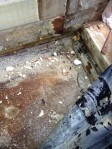
~ Common Indications
PLASTER CRACKS
One of the most common causes of a leaky plaster home is plaster cracking, the heating and cooling of the plaster and paint products that have previously been used in our common building practice over the last two decades in many cases just don’t cut it.

There are a number of causes for plaster cracks to appear in leaky homes or potentially leaky homes. The most common is the fact that most plasterers, even today, do not use a reinforcing mesh. Consumers beware! Another, is the fact that most plasterers also use porous plaster systems rather than a step by step waterproof plastering system, this leaves all faith in an external, weather exposed, super thin water proof membrane…the paint. Common sense will tell you that’s not a good idea, even if you’re not a tradesman, it’s like putting a plaster on your skin and hoping it won’t get come off in the rain. Once the water has penetrated the plaster it then is absorbed through the cladding (in most cases unsealed ‘porous’ Hardie board) if it has not been sealed. Once there, the timber becomes a sponge and capillary action sets in.
We have seen moisture travel up to 5 meters from the ‘leaks’ point of entry. It does this by travelling through what was once the tree’s rings or veins in which the tree used to carry ‘sap’ to feed itself and is now carrying water to destroy your leaky homes structural integrity. Once the timber is soft and the decomposing has begun the cracks start to show externally on your building due to the movement of the decaying timber substrate under the cladding.
LEAKY DECKS
 Another of the most common waterproof membrane failures on leaky homes are decking membranes, this is an example of a failed butinol membrane and the result of capillary action in timber. As you can see once absorbed the moisture follows the grain of the timber much like the sap would have when the tree was alive. This ‘capillary action’ in leaky homes is the most common and damaging form of moisture traveling behind the cosmetics of your home, also destroying the timber as it travels, resulting in structural integrity problems and remedial work.
Another of the most common waterproof membrane failures on leaky homes are decking membranes, this is an example of a failed butinol membrane and the result of capillary action in timber. As you can see once absorbed the moisture follows the grain of the timber much like the sap would have when the tree was alive. This ‘capillary action’ in leaky homes is the most common and damaging form of moisture traveling behind the cosmetics of your home, also destroying the timber as it travels, resulting in structural integrity problems and remedial work.
When addressing this work you must remove the affected timber! Not just repair the source. Any rot that has penetrated your timber will leave a toxic black mould spore pigment, once set in, it is an extreme health hazard and must be removed! Wet rot eventuates to dry rot once the leak source is repaired and will continue to spread throughout your home undetected, soon to become an airborne spore in which is a serious health hazard! We have all seen the developments of illness, disease and fatalities from these sicknesses in recent years of unaddressed leaks in South Auckland state housing.
DO YOUR RESEARCH! ATTACK NOW!
ANTS! SLATERS!

If you have leaky repair issues and your finding ants around your area of concern, YOU SHOULD BE CONCERNED! Finding ants just about guarantees you have the need for remedial frame work.

Ants love the moisture in h1 framing. It creates an environment where they can thrive from eating and digging the softened rotted timber away. If you have ants, you have UNDERLYING ROT!
The same as the ants slaters love the wet timber environment in leaky homes, if you have Slaters sort it out, call now!